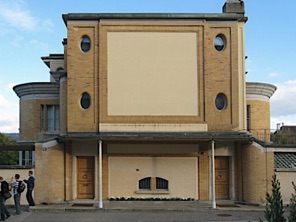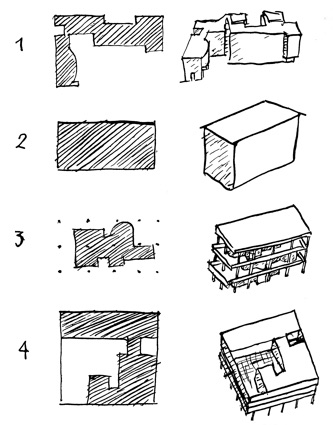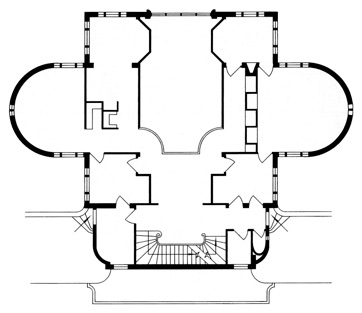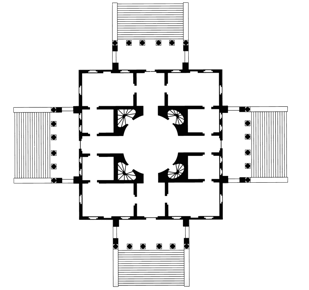-
5)Diagram of 4 House Types, from Oeuvre Complète, Le Corbusier, 1910-1929
Space and Anti-Space
The form in which space is presumed to exist is the framework of our perception of the world. Space, as idea, is the intangible qualifier of our vision of form, of location and dimension, establishing the relative measure among physical things (figure 1). Yet recent criticism and current architectural polemics overlook or take for granted the exact nature of the definition of space and seem oblivious to the consequences.
To achieve any significant development and growth in architecture, it is essential to clarify the restrictions imposed by modern space. Both Modern Architecture and contemporary society in general have accepted the destruction of volumetric space in order to achieve other things; and this fact conditions all our current conceptions of meaning and form.
Because of this, no criticism of Modern Architecture can be complete and no post mortem version of it can be successful without a more exact understanding of what is meant by Modern space. Its unique effects are all-pervasive and can only be overcome by re-evaluating our basic conceptions and transforming our actual sensibility to space itself. Built-in biases must be reversed so the fact can be established that space is by definition neither ineffable nor abstract. It is an entity which has form and identity. It can be subject to analysis and criticism.
This critique of space which is so necessary for architecture has not occurred and remains problematic largely because there is no longer a valid, constructive approach to solutions at a time of crisis. The confusion derives from a fundamental attitude toward change which has become inverted: it is now no longer based on anticipation but on retrospection; it is no longer an Avant Garde revolution, but has become instead a conservative reaction. Still, through uncritical habit, the approach to problems is couched in the familiar spirit of progressivism; revolutionary actions continue but without an adequate process or program to focus conviction.
While we can now recognize and agree on the limitations of the Modern style, justifiably discrediting some of its results, we must also accept the loss of the avant garde itself and identify the disjunction between this as a cultural process and new, potentially contradictory intentions. The uncritical continuation of the avant garde attitude of crises leads only to its unconscious transformation into a posture of dandyism. Just as the 18th century dandy attempted to fulfill the social role of the lost aristocracy by substituting an extravagant posture for a legitimate old position, the current posturing of the Avant Garde architect is a false re-enactment. Ever-new inventions required of 21st century “starchitect” buildings, continues this re-enactment of newness for its own sake.
There is now a prevailing sense of nostalgia for the position provided by the lost Avant Garde. The past is approached as a substitute for missing convictions about the future. New beliefs are postured with extravagant taste and changing rhetoric. There is hope that this will still provide legitimate new answers, but it is a struggle within an old procedure, which is maintained to keep up with the imagined need for new movements.
The danger in this nostalgic emulation of the Avant Garde is the risk of being dazzled only by performance itself, or blinded by the simplistic identity and popular success of extreme positions. In the rush for notoriety, useful information and ideas may be passed over; the value of intelligent criticism may be obscured.
We are now at a starting point similar to the beginning of the Modern Movement when there was complete frustration with the limitations of the prevailing styles. Despite new enthusiasm and fresh stirrings of expectation, no clear and satisfactory direction for a new architecture had yet emerged as exemplified by Le Corbusier’s Villa Schwob, which represents a struggle between old spatial volumes and new forms of accommodation planning (figure 2a, figure 2b). The situation is remarkably similar to Mies' description of the mood in 1910:
-
“We find ourselves in painful inner discord. Our enthusiastic hearts demand the unqualified and we are ready to pledge ourselves to an idea, but the potential vitality of the period has by this time been lost.”
The mood today is the same but the conditions are different. The idea and theory of the Avant Garde provided a solution to the dilemma for architects in 1910. The revolt against prevailing forms was in itself a source for the energy of invention.
There were no regrets, no hesitations. Now, we no longer can be shocked by the proposal of new styles because our vulnerability has been hardened through repetition. Our faith in both the modern utopia and its methods has been exhausted.
-
2)a. Villa Schwob, second floor plan.
Early modern plans struggled to combine expressive exterior forms and the thinness of interior partitioning
-
2)b. Villa Schwob, front facade.
The Loss of Space
What is Modern space? The evidence for a confused and incomplete criticism of space is found throughout the entire spectrum of contemporary writings on architecture (see Box 1: Post-Modern and Neo-Rational) although a specific definition of Modern space consistently emerges. In a typical example, architectural space is described by Charles Moore and Gerald Allen in Dimensions-Space Shape and Scale,1976, as:
-
“...a special category of free space, phenomenally created by the architect when he gives a part of free space shape and scale...we cut off a piece of space from the continuum of all space,...to make it recognizable as domain.”
This notion of space, as a slice of the continuum, forms the underlying assumption of Modern Architecture. Space is conceived to be a free element in nature, a found resource. It is thought to be transcendental, abstract, continuous, vast, and with no form. This is a repetition of the Platonic ideal concept of space described by Rudolph Arnheim in The Dynamics of Architectural Form,1977, as:
-
“...the mother and receptacle of all created and visible and in any way sensible things...the universal nature which receives all bodies...for while receiving all things she never departs at all from her own nature and never in any way or at any time assumes a form like that of any of the things which enter into her”.
This concept of formless universal space is hypothesized by psychologists as a basic condition of perception: Arnheim suggests that modern “space is experienced as the given which precedes the objects in it. In the absence of such objects (it is assumed) space would still exist, as an empty boundless container.” In other words, modern space is exclusively perceived as the background for the figure of form, as the a priori natural condition.
This concept of natural space becomes romanticized and imbued with a kind of implicit animism. Moore and Allen even propose that:
-
“You can capture space and let it go, 'define' it or 'explode' it. Space is surely one of the things you have more of after you have 'exploded' it, but it seems to thrive in captivity too.”
There is a sense here that, space prefers a free habitat, that it needs to be captured and domesticated like a wild beast.
One can imagine a typical modern interior in these terms, as an attempt to make one's particular piece of wild natural space feel at home. The informal arrangement of walls and the lifting of all the furniture off the floor, allows the free and natural movement of one’s own house space. Like a domestic pet it is allowed to roam freely throughout the interior. The white walls, the elimination of clutter, the purity of design are placations to the pure habitat of this captured creature. Even the inevitable modern house plants casually but strategically placed can be seen as a supplication to this special pet space cut off from its true source of nourishment in the natural continuum.
There is an aspect of respect and deference inherent in this idea. Like the notion of ecology, neither space nor nature should be overly affected by man's presence. Nature and its coincident image of space are to be left in balance so that Modern space is conceived to be an independent entity, essentially unaffected by willful human intervention.
A definition of modern space emerges almost by consensus from these observations. It is a definition which one suspects is shared unconsciously to some degree by everyone. That is: modern space is a natural phenomena, a found condition; it is imagined as an a priori continuum; it has scientific connotations similar to the field theories of light and energy, it is ever present, untouchable, and abstract.
Being indefinite, it cannot carry meaning and must remain the background condition for object forms. It can no longer be imagined as a medium of design itself. This is the most limiting assumption, that it is wrong or presumptuous to try and make space—it cannot be subject to man's intervention nor to the manipulation of his imagination. Modern space cannot be conceived as having form.
The powerful influence of Modern space and its ubiquitous casual presence derive from its singular image as the embodiment of nature, as an untouched pristine void. It is a precondition that pervades our entire culture, from the individual ordinary realms of furnishing and fashion to the macro-environmental scales of architecture and urban design. This idea of space is assumed to be inherent, the natural, intangible condition.
Because it is the given, the blank formless, ever-present background, it is overlooked, unnoticed and untouched. It is endemic, the invisible pre-condition of most contemporary design. Ever present, it can be observed in both the Las Vegas of pop architecture and the early modernism of the Ville Radieuse. The underlying endless space is the same, except one has billboards (see Box 2: Las Vegas and Le Corbusier). It continues to be the default condition for most planning and urban design today, epitomized by Shanghai’s new Pudong district, where the underlying blanket of formless space cannot provide a coherent overall structure to the area. The prevailing uniform void just forces the scattered architectural objects into an extravagant dissonant competition.
The inherent blandness of modern space eliminates the possibility of urban place, but also demands ever new and exaggerated architectural inventions to compensate. The so-called freedom of open modern space is deceptive because it is actually proscriptive, narrowing formal options and eliminating compositional choices.
To compensate, an alternative spatial hypothesis is needed, one that advocates for constructed space. This is certainly possible: space can be man-made, defined, not just found; it can be willfully created; it can be made to have form and geometric order; it can be limited; it can be figure as well as ground. Space can be treated as a plastic medium of design, separate from nature. Architectural space is still accessible. It is a significant human innovation, developed over a long history that has unwittingly been discarded.
Space and Anti-Space
There are two fundamental conceptions of space that have opposite and contradictory attributes. It is such an extreme opposition that it can be compared to the theory in modern physics of matter and anti-matter, which postulates the existence of two different kinds of matter in the universe, composed of equal but oppositely charged particles, so that any coincident meeting or collision of the two will cause their mutual annihilation.
According to this analogy, Modern space, is the anti-space that will annihilate space. Space and Anti-space are oppositely “charged”. Anti-space is undifferentiated, formless, infinite, universal, singular, and continuous. Space is differentiated, formed, finite, particular, multiple, and discontinuous. Space, by definition, will be obliterated by the presence of Anti-space
Complete, uncritical subscription to the limited sensibility of Modern space, or anti-space, leads to the erosion and eventual loss of space and its capacities. The results of this can be seen all around us. It is no longer possible to make a stable public space, to design a street or square, or simply form the boundaries of a good room. The sensibility as well as the skill to accomplish this have been lost. While we are aware of both types of space, there is a predisposition to use only one; modern life is conceived only in terms of anti-space.
Each of these two space types is defined more precisely through a description of both the conceptual form ascribed to them and their assumed properties (see Box 3: The Fundamental Dichotomy). Space is conceived as a differentiated volume, identifiable in its configuration as form, discontinuous in principle, closed and static, but also capable of plastic form. It is serial in composition. Anti-space is the opposite. It is undifferentiated and ideally formless, continuous in principle, open and flowing. It is controlled, directed, or temporarily captured, but never composed.
While, perceptually, the actual visual occurrence of either space or anti-space is realized only in the presence of physical things, the illusion of what is seen between these things is in each case different. Anti-space appears indefinite; it is perceived as the tension and direction in between things. Space is specific; it is perceived as the form of the “in-between” itself. This condition is unique to space and is the essence of its definition. The successful appearance of this illusion of in-between form is almost tangible: something is there. Space does not appear empty; anti-space does, despite its animation and flow. Space as opposed to anti-space has identity and value—it is charged with a presence. It seems to exist in itself and have properties which are tangible: scale, proportion, shape, and size. Its configurations can be measured and its limits defined. Anti-space is imperceptible. It is never explicit.
Historically, the two types of space derive from different world views (see Box 4: A Brief History of Space). When space was the dominant concept, its underlying assumptions were a finite universe of Cartesian geometric order, a harmony of simple mathematical ratios interpretable through geometry. The universe of space was imagined as an assembly of pure and crystalline forms whose structure, although hidden from ordinary appearances, was the presumed truth, the underlying order. Random nature was accepted in this scheme as a profane, unconverted realm, hiding beneath the true order. The ideal city was the sacred realization of formed space.
As the universal validity of Euclidean geometry and Newtonian physics were questioned and expanded, anti-space emerged as dominant. When “truth” became less certain, the underlying assumptions relating to anti-space became an infinite universe, a continuum approaching entropy, a condition of pure probabilities and random events decipherable only through statistics. Free random nature came to symbolize the truth of reality in its unadulterated state. As such, it came to be the proper source of knowledge and the subject of science. Within the tenets of anti-space, the precision of the city as a reference to pure form and contrived figures of design was now interpreted as an esoteric invention without validity.
The dominance of anti-space as the prevailing spatial sensibility was reinforced by the concepts of romanticism. When the individual vision replaces man's general vision as the framework for interpretation, each person establishes his own relationship to nature as the primal source. After this occurs, there can no longer be a convention of universal perception. Space itself loses value since the correctness of composition is determined by the picture it makes for each individual (the picturesque). Geometry as a generalization of form becomes separate from space and is used primarily as a neutral, referential grid, serving as the necessary coordinates (Cartesian) that underlie the scientific description that lurks beneath a larger romantic natural milieu.
This change from the idea of space to anti-space and the consequent deterioration of the sensibility to figural space can be seen quite clearly in the image and drawing of architectural plans. When Durand draws a Palladian villa, space is somehow missing. Although the type remains, it has been neutralized and converted into a mere geometric pattern of lines separated from the Space they enclose (figure 3a, figure 3b). Palladio’s rotunda is spatially full, Durand’s is just the grid.
-
3)a. Plan Drawings, J N L Durand.
-
3)b. Villa Rotunda, Vicenza, Italy, Andrea Palladio, c 1554.
The change in sensibility from space to anti-space is also observable in the altered configuration of both the garden and the city. When the Bois de Boulogne was converted to an English park landscape, it supplanted a forest of geometric space. A wandering circulatory system replaced the taut linear allées which form the spatial relationships between the edges. Nature is re-established as sacred, tamed by its association with anti-space.
It is apparent that the foundation of Modern Architecture rests on a different interpretation of space; one that is a fluid, pre-existing, natural, condition rather than an imposed construction. Modern space is Anti-spacial because it is exclusive of any other interpretations or formal impositions other than the natural. Any man-made figural manipulations of it would violate its basic assumption. All its attributes correspond to its conception as a natural phenomenon: a “free” open plan, the literal interpenetration of indoors as outdoors, buildings seen as finite objects, standing in the infinity of space around them, architecture raised off the ground to encourage the uninterrupted and continuous flow. Nature dominates and is encouraged everywhere. All exteriors are landscaped. The ordered garden is not allowed, especially with nature’s own hedges and trees. Modern space is an uninterrupted fluid, a moving ubiquitous continuum. It is Anti-space, because it annihilates the very possibility of figural formed Space.
Looking back at Le Corbusier's diagram of the Five Points (figure 4), a sixth point can now be imagined as the unspoken common link to the other five. It is clear that a new idea of space is present in all the drawings on the left side. Le Corbusier’s “ineffable space” (intangible and inexpressible) is an Anti-space, without walls, without rooms. The whole history of Space on the right will be annihilated by Anti-space on the left.
In Le Corbusier's other diagram of the four compositional types (figure 5), there is also the implicit presence of an exterior void, which remains untouchable and continuous, with each building free-standing in it, self sufficient, alone without context.
It seems clear that no transformation of architecture can take place without first recognizing the power of this sixth point and its influence as an unconscious spatial bias. Anti-space is deeply imbedded in the whole framework of contemporary society. It is further reinforced by the prevalent political concepts of individualism, capitalism, and commercialism as the dominant contemporary forms. The undifferentiated, uniformly-equal value of anti-space serves as the perfect equivalent of an undifferentiated society of equals. Its abstraction is embraced as a metaphor for freedom and equality, while its implicit openness continues to symbolize the general scientific image of free nature.
Despite the apparent cultural integration of this spatial concept its effects are disastrous. The free, flowing aspect of anti-space obliterates the important distinctions necessary for the definition of place, the formed location between things. Place requires constructed Space with unique specificity, confinement and closure, with measurable scale. By making everywhere the same, Anti-space destroys honorific distinctions between public and private realms, breaking down the barriers and layers required for transitional passage.
This modern, Anti-space is defined by its opposite. It derives its authority from the obliteration and rejection of space itself. Anti-space, because it is by definition formless, can carry no specific meaning beyond its transcendental aspirations. If there can be no form without meaning, there can be no meaning without a form. An inarticulate vacuum is the inevitable consequence of the elimination of formed figural space as a medium of architectural manipulation.
Surely this contributes in a significant way to the current crisis of meaning in architecture. The concept of a universal inexpressive anti-space, must result in the rejection of figural space. This induces a loss of formal capacity and a reduction in communicative content. To re-establish place, Space needs to be re-incorporated into architecture.
4
3
2
1
-
4)‘Five Points’, from Oeuvre Complète, Le Corbusier, 1910-1929





